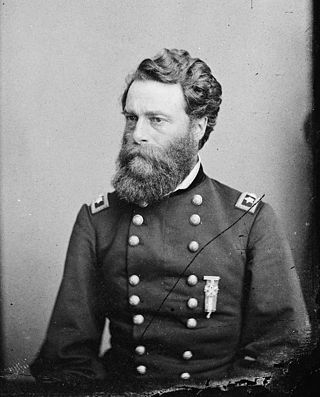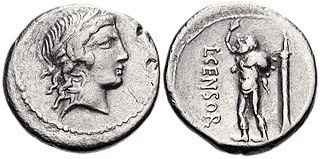
The Battle of Pharsalus was the decisive battle of Caesar's Civil War fought on 9 August 48 BC near Pharsalus in Central Greece. Julius Caesar and his allies formed up opposite the army of the Roman Republic under the command of Pompey. Pompey had the backing of a majority of Roman senators and his army significantly outnumbered the veteran Caesarian legions.

The Battle of Thapsus was a military engagement that took place on April 6, 46 BC near Thapsus. The forces of the Optimates, led by Quintus Caecilius Metellus Scipio, were defeated by the forces of Julius Caesar. It was followed shortly by the suicides of Scipio and his ally, Cato the Younger, the Numidian King Juba, and his Roman peer Marcus Petreius.

The Battle of Mansfield, also known as the Battle of Sabine Crossroads, on April 8, 1864, in Louisiana formed part of the Red River Campaign during the American Civil War, when Union forces were attempting to occupy the Louisiana state capital, Shreveport.

The Battle of Poison Spring was fought in Ouachita County, Arkansas on April 18, 1864, as part of the Camden Expedition, during the American Civil War. A Union force commanded by Major General Frederick Steele had moved from Little Rock, Arkansas towards Shreveport, Louisiana in support of Major-General Nathaniel Banks' move up the Red River towards Shreveport. After Banks was defeated at the battles of Mansfield and Pleasant Hill, Steele was isolated in Arkansas. Short on supplies, Steele sent a detachment commanded by Colonel James M. Williams to search for supplies. Williams' column was attacked by Confederate troops under the command of Brigadiers General John S. Marmaduke and Samuel B. Maxey. After a sharp fight, Williams' command was routed, losing its wagon train and four cannons. The defeat at Poison Spring and another defeat at the Battle of Marks' Mills a week later led Steele to retreat to Little Rock. The battle is infamous for the Confederates' slaughter and mutilation of African-American Union soldiers of the 1st Kansas Colored Infantry. Poison Springs Battleground State Park, which is part of the Camden Expedition Sites National Historic Landmark, preserves a portion of the site of the battle.
The Battle of Ruspina was fought on 4 January 46 BC in the Roman province of Africa, between the Republican forces of the Optimates and forces loyal to Julius Caesar. The Republican army was commanded by Titus Labienus, Caesar's former lieutenant during the Gallic Wars who had defected to the Republican side at the beginning of the civil war.

Joseph Anthony Mower was a Union general during the American Civil War. He was a competent officer, and he was well respected by his troops and fellow officers. He was known among his troops as "Fighting Joe". Major General William Tecumseh Sherman said of Mower, "he's the boldest young officer we have".

The Battle of Honey Springs, also known as the Affair at Elk Creek, on July 17, 1863, was an American Civil War engagement and an important victory for Union forces in their efforts to gain control of the Indian Territory. It was the largest confrontation between Union and Confederate forces in the area that would eventually become Oklahoma. The engagement was also unique in the fact that white soldiers were the minority in both fighting forces. Native Americans made up a significant portion of each of the opposing armies and the Union force contained African-American units.
The Bellum Siculum was an Ancient Roman civil war waged between 42 BC and 36 BC by the forces of the Second Triumvirate and Sextus Pompey, the last surviving son of Pompey the Great and the last leader of the Optimate faction. The war consisted of mostly a number of naval engagements throughout the Mediterranean Sea and a land campaign primarily in Sicily that eventually ended in a victory for the Triumvirate and Sextus Pompey's death. The conflict is notable as the last stand of any organised opposition to the Triumvirate.

The Second Battle of Cynthiana included three separate engagements during the American Civil War that were fought on June 11 and 12, 1864, in Harrison County, Kentucky, in and near the town of Cynthiana. This was part of Confederate Brigadier General John H. Morgan's 1864 Raid into Kentucky. The battle ultimately resulted in a victory by Union forces over the raiders and ended Morgan's Last Kentucky Raid in defeat. Morgan's command had previously captured the town in the First Battle of Cynthiana, July 17, 1862.

The 9th Regiment Massachusetts Volunteer Infantry was a military unit from Boston, Massachusetts, USA, part of the Army of the Potomac during the American Civil War. It is also known as "The Fighting Ninth". It existed from 1861 to 1864 and participated in several key battles during the war. The unit is an Irish heritage unit, with many volunteers having been born in Ireland.

The Battle of Sacriportus also called the Battle of Sacriporto took place in April of 82 BC during Sulla's Second Civil War. The battle pitted the Optimates under the command of Lucius Cornelius Sulla Felix against the Populares forces commanded by Gaius Marius the Younger. The battle resulted in a decisive Optimate victory.
The First Battle of Clusium was a battle that took place in June of 82 BC during the Roman Republic's Second Civil War. The battle pitted the Optimates under the command of Lucius Cornelius Sulla against the Populares commanded by Gnaeus Papirius Carbo. The battle was indecisive.

The Battle of Faventia was a battle that took place in September of 82 BC at Faventia during the context of Sulla's Second Civil War. The battle pitted the Optimates under the command of Quintus Caecilius Metellus Pius against the Populares forces commanded by Gaius Norbanus Balbus. The battle resulted in an Optimate victory.

The Battle of Fidentia was a battle that took place in September of 82 BC at Fidentia during the context of Sulla's Second Civil War. The battle pitted the Optimates under the command of Marcus Terentius Varro Lucullus against the Populares forces commanded by Lucius Quincius. The battle resulted in a decisive Optimate victory.

The Battle of Sena Gallica was a battle that took place in April or May of 82 BC during the context of Sulla's Second Civil War in the area around present day Senigallia. The battle pitted the Optimates under the command of Gnaeus Pompeius Magnus, legatus of Lucius Cornelius Sulla Felix against the Populares forces commanded by Gaius Marcius Censorinus who was in turn the legatus of Gnaeus Papirius Carbo. The battle resulted in a decisive Optimate victory. Immediately following the battle, the town was subjected to a brutal sacking by Sulla's victorious forces.
The Battle of Hippo Regius was a naval encounter during Caesar's Civil War which occurred off the coast of the African city of Hippo Regius in 46 BC. Metellus Scipio and a number of influential senators from the Optimate faction were fleeing the disastrous Battle of Thapsus when their fleet was intercepted and destroyed by Publius Sittius, a mercenary commander in the employ of the Mauretanian king Bogud, an ally of Gaius Julius Caesar's. Scipio committed suicide and all of the other senators were killed during the battle.
The siege of Curicta was a military confrontation that took place during the early stages of Caesar's Civil War. Occurring in 49 BC, it saw a significant force of Populares commanded by Gaius Antonius besieged on the island of Curicta by an Optimate fleet under Lucius Scribonius Libo and Marcus Octavius. It immediately followed and was the result of a naval defeat by Publius Cornelius Dolabella and Antonius eventually capitulated under prolonged siege. These two defeats were some of the most significant suffered by the Populares during the civil war.












